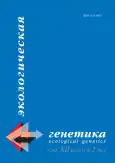Характеристика генетической структуры популяции Северо-западного региона РФ по гену HLA-G
- Авторы: Аленичев А.П.1, Насыхова Ю.А.2, Иващенко Т.Э.2, Баранов В.С.2
-
Учреждения:
- Санкт-Петербургский государственный университет
- ФГБУ НИИ акушерства и гинекологии им. Д. О. Отта Северо-Западного отделения РАМН
- Выпуск: Том 12, № 2 (2014)
- Страницы: 74-80
- Раздел: Статьи
- URL: https://journals.rcsi.science/ecolgenet/article/view/2451
- DOI: https://doi.org/10.17816/ecogen12274-80
- ID: 2451
Цитировать
Полный текст
Аннотация
Ключевые слова
Полный текст
Открыть статью на сайте журналаОб авторах
Арсений Павлович Аленичев
Санкт-Петербургский государственный университет
Email: senyaa@list.ru
студент, кафедра генетики и биотехнологии
Юлия Алмазовна Насыхова
ФГБУ НИИ акушерства и гинекологии им. Д. О. Отта Северо-Западного отделения РАМН
Email: yulnasa@gmail.com
к. б. н., научный сотрудник, лаборатория пренатальной диагностики наследственных и врожденных заболеваний человека
Татьяна Эдуардовна Иващенко
ФГБУ НИИ акушерства и гинекологии им. Д. О. Отта Северо-Западного отделения РАМН
Email: tivashchenko2011@mail.ru
д. б. н., профессор, в. н. с., лаборатория пренатальной диагностики врожденных и наследственных заболеваний
Владислав Сергеевич Баранов
ФГБУ НИИ акушерства и гинекологии им. Д. О. Отта Северо-Западного отделения РАМН
Email: baranov@vb2475.spb.edu
д. м. н., профессор, член-корр. РАМН, лаборатория пренатальной диагностики врожденных и наследственных заболеваний
Список литературы
- Castro M. J., Morales P., Fernández-Soria V., et al. (1996) Allelic diversity at the primate Mhc-G locus: exon 3 bears stop codons in all Cercophitecinae sequences.Immunogenetics]. Vol. 43. P. 327.
- Donadi E. A., Castelli E. C., Arnaiz-Villena A. et al. (2011). Implications of the polymorphism of HLA-G on its function, regulation, evolution and disease association], Cellular and molecular life sciences: CMLS. Vol. 68 (3). P. 369-395.
- Glas J., Török H. P, Tonenchi L. et al. (2007). The 14-bp deletion polymorphism in the HLA-G gene displays significant differences between ulcerative colitis and Crohn’s disease and is associated with ileocecal resection in Crohn's disease], International immunology. Vol. 19 (5). P. 621-626.
- Hviid T. V. F., Hylenius S., Lindhard A., Christiansen O. B. (2004). Association between human leukocyte antigen-G genotype and success of in vitro fertilization and pregnancy outcome], Tissue antigens. Vol. 64 (1). P. 66-69
- Jiang, Yuting, Shougong Chen, Shasha Jia et al. (2011). Association of HLA-G 3’ UTR 14-bp insertion/deletion polymorphism with hepatocellular carcinoma susceptibility in a Chinese population], DNA and cell biology. Vol. 30 (12). P. 1027-1032.
- Killeen, Peter R. (2005). An alternative to null-hypothesis significance tests], Psychological science. Vol. 16 (5). P. 345-353.
- Loustau M., Wiendl H., Ferrone S., Carosella E. D. (2013). HLA-G 2012 conference: the 15-year milestone update], Tissue antigens. Vol. 81 (3). P. 127-136.
- Moreau P., Contu L., Alba F. et al. (2008). HLA-G gene polymorphism in human placentas: possible association of G*0106 allele with preeclampsia and miscarriage], Biology of reproduction. Vol. 79 (3). P. 459-467.
- Ober C., Billstrand C., Kuldanek S., Tan Z. (2006). The miscarriage-associated HLA-G -725G allele influences transcription rates in JEG-3 cells], Human reproduction (Oxford, England). Vol. 21 (7). P. 1743-178.
- Ober C., Aldrich C. L., Chervoneva I. et al. (2003). Variation in the HLA-G promoter region influences miscarriage rates], American journal of human genetics. Vol. 72 (6). P. 1425-1435.
- Rousseau P., Le Discorde M., Mouillot G. et al. (2003). The 14 bp deletion-insertion polymorphism in the 3’ UT region of the HLA-G gene influences HLA-G mRNA stability], Human immunology. Vol. 64 (11): 1005-1010
- Sipak-Szmigiel, Cybulski O. C., Wokołorczyk D. et al. (2009). HLA-G polymorphism and in vitro fertilization failure in a Polish population], Tissue antigens. Vol. 73 (4). P. 348-352.
- Tripathi P., Abbas A., Naik S., Agrawal S. (2004). Role of 14-bp deletion in the HLA-G gene in the maintenance of pregnancy], Tissue antigens. Vol. 64 (6). P. 706-710.
- Veit, Degani T., Vianna P. et al. (2008). Association of the HLA-G 14-bp insertion/deletion polymorphism with juvenile idiopathic arthritis and rheumatoid arthritis], Tissue antigens. Vol. 71 (5). P. 440-446.
Дополнительные файлы






